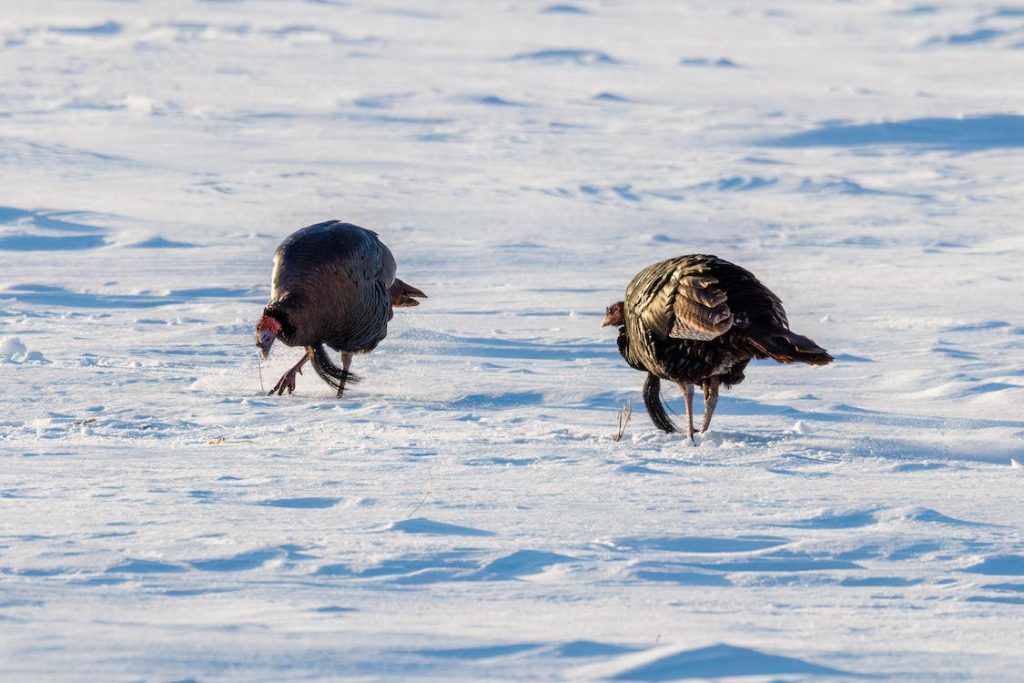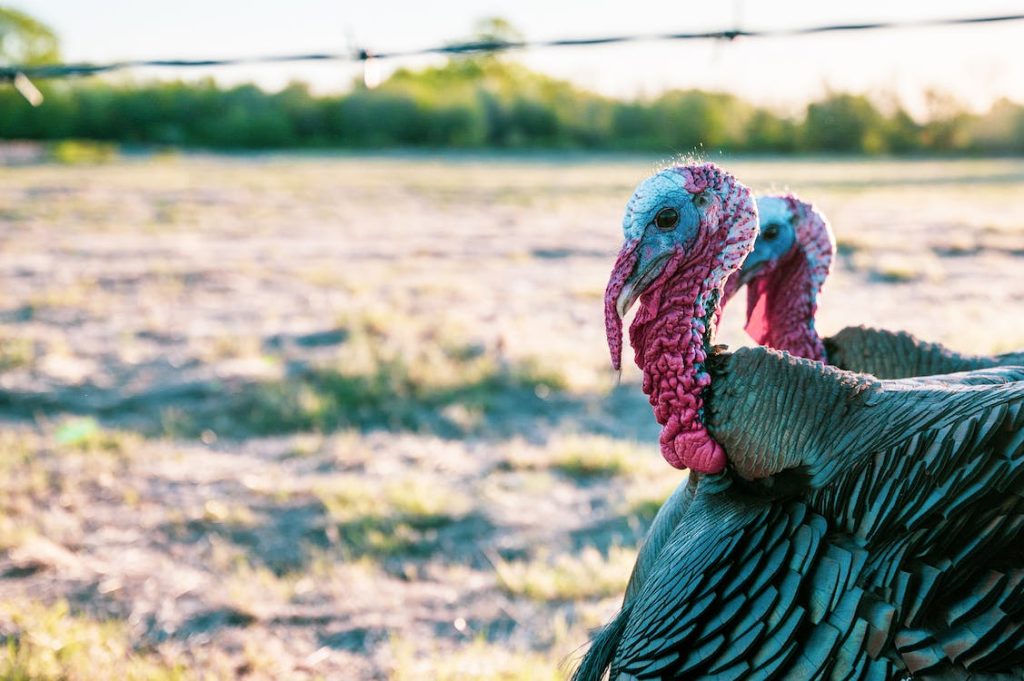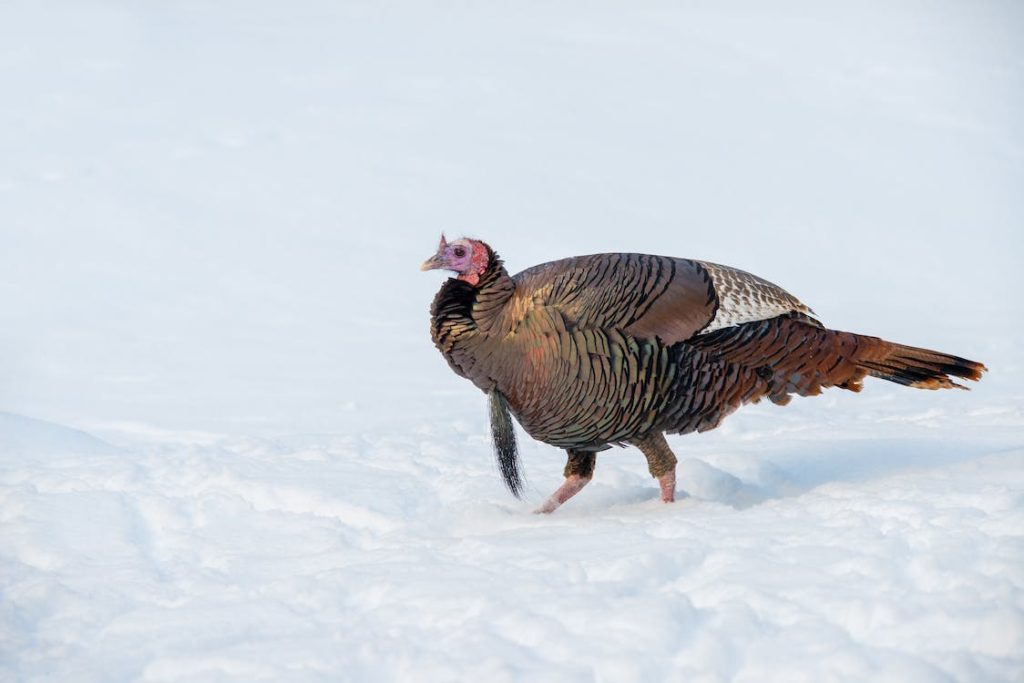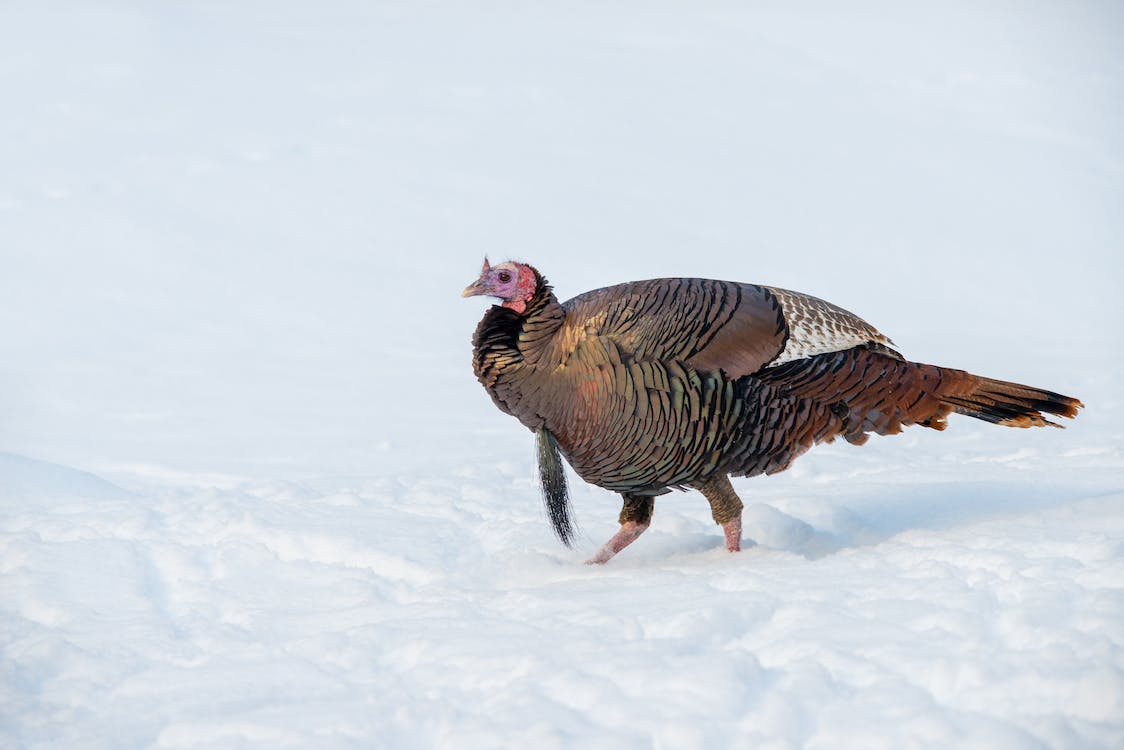Have you ever found yourself wondering if turkeys can swim?
Can turkeys swim? This is an interesting and thoughtful question that may have crossed your mind several times, especially if you’ve observed these large birds in action.
When we think of turkeys, images of Thanksgiving feasts and sprawling farmlands often come to mind.
We picture them confidently strolling around with their eye-catching feathers, happily feasting as they explore their terrestrial surroundings.
However, when it comes to their aquatic abilities, the answers might not be as straightforward as we assume.
In this blog post, we will dive deep into whether these feathered creatures have what it takes to swim through the water. Well, get ready to uncover the surprising truth about Turkey’s swimming ability.
A Brief Overview of the Anatomy of Turkeys
Before we dive into the specifics, it’s essential to understand the anatomy of turkeys and how it may affect their swimming potential.

Turkeys are large, strong birds with well-developed breast muscles, making them powerful flyers.
However, it’s important to note that their robust physique doesn’t automatically equate to exceptional swimming capabilities. After all, flying and swimming require different adaptations.
So, can turkeys swim? The answer lies in their physical attributes and behavioral patterns.
In the following sections of this blog post, we will explore these factors in detail to shed light on the truth about Turkey’s swimming ability.
By the end of this article, you’ll have a clearer understanding of the truth behind the swimming abilities of turkeys, and you may even find yourself viewing these remarkable creatures in a whole new light.
Can Turkeys Swim?
To put it simply, yes, turkeys can indeed swim. While it may not be their preferred method of movement, they are capable of staying afloat and moving through the water when necessary.
However, it’s important to note that not all turkeys are proficient swimmers, and their swimming abilities can vary among each type of turkeys.
Common Misconceptions about Turkey’s Swimming Ability
- Turkeys drown when it rains
One common misconception is that turkeys are unable to withstand rainfall due to their alleged inability to swim.
However, turkeys are naturally with feathers that possess natural oils, helping to fend off water and keeping them moderately dry even during rain showers.
While they may seek shelter during heavy downpours, it is not due to their inability to swim.
- Turkeys are afraid of water
Another misconception is that turkeys have natural fear or hate for water.
While turkeys may exhibit some caution around bodies of water, especially if they are unfamiliar with them, this behavior can be attributed to their natural, instincts of self-preservation rather than a fear of swimming itself.
READ ALSO: Top 12 Swimmers Star Quality That’s Hard to Define
Scientific Studies and Observations about Turkey’s Swimming Ability
Scientific studies have provided valuable insights into the swimming capabilities of turkeys.
Researchers have observed wild turkeys crossing rivers and swimming short distances to reach new habitats or escape predators.
These observations indicate that while swimming may not be their primary mode of transportation, turkeys possess the physical adaptations necessary for this activity.

Turkeys have webbed feet, which aid in their movement in the water. Additionally, their dense feathers called plumage helps to provide buoyancy and covering while swimming.
These adaptations allow turkeys to paddle their way through the water, although they may not be as proficient as other water-dwelling birds.
It’s worth noting that not all domesticated turkeys possess the same swimming abilities as their wild counterparts.
Selective breeding for specific traits in domestic turkeys has led to variations in their physical characteristics, including their swimming capabilities.
Physical Attributes of Turkeys
Turkeys, members of the genus Meleagris, exhibit a well-defined body structure that showcases their adaptability to various environments.
They belong to the order Galliformes and are characterized by their robust build and long legs.
Adult turkeys typically reach a height of 2, 3 to 4 feet and have a wingspan ranging from 4.5 to 5 feet.
Their impressive size and well-built frame allow them to survive in diverse habitats, including woodlands, grasslands, and even aquatic environments.
The head of a turkey is adorned with fascinating features, such as a fleshy, bumpy appendage known as the snood, which extends from the forehead and hangs over the beak.
The snood’s purpose extends beyond aesthetics, it can change in color and size to indicate the bird’s mood or health.
Additionally, turkeys possess a caruncle, a fleshy protuberance located on the upper neck, which can change color during courtship displays or when they become excited.
Turkey’s Specific Features for Swimming
While turkeys are primarily terrestrial birds, they are surprisingly good at swimming, especially when necessary to protect themselves from predators or access food sources.
Several physical attributes contribute to their swimming abilities. Below are some of the features that contribute to their swimming abilities:
- Webbed Feet:
Turkeys possess partially webbed feet, with the front toes joined by a membrane.
This feature enhances their ability to paddle through the water, making them efficient swimmers when compared to other land-based birds.
The webbing increases surface area, providing better movement in the water.
- Oily Plumage:
The feathers of turkeys feature an oily coating that repels water, allowing them to stay buoyant and maintain their body temperature even when swimming for extended periods.
This waterproofing mechanism is essential for their survival in wetland environments.
- Powerful Wings:
Although turkeys are not strong fliers, their wings serve an important purpose in the water.
When swimming, they can use their wings to generate additional thrust, aiding in movement and stability in the water.
Turkeys Swimming Abilities Comparison with other Waterfowl Species
While turkeys may not be as widely recognized for their swimming abilities as ducks or geese, they do possess certain characteristics that set them apart.

Below are some of the characteristics that set turkeys apart from other waterfowl species:
- Adaptability:
Turkeys exhibit a remarkable adaptability in their habitat preferences, allowing them to survive in both terrestrial and aquatic ecosystems.
Unlike many waterfowl species that rely solely on aquatic environments, turkeys can adapt to a broader range of landscapes, including woodlands, grasslands, and swamps.
- Swimming Style:
Turkeys utilize a unique swimming technique, different from the typical paddling motion observed in ducks and swans.
Rather than relying on their webbed feet alone, turkeys combine foot movement with occasional wing flapping to propel themselves through the water efficiently.
- Diving Abilities:
While turkeys are not known for their diving skills like certain waterfowl species, they can submerge their bodies partially and hold their breath for short periods when searching for food underwater.
This capability allows them to access aquatic grasses and living creatures without bones found beneath the water surface.
READ ALSO: Can Foxes Swim? Discover the Surprising Truth
How Turkeys Utilize Swimming for Survival
We will explore various situations in which turkeys utilize swimming for their survival.
- Escaping Predators:
Swimming serves as an effective escape strategy for turkeys when faced with dangerous predators.
Predators like foxes, coyotes, and feral dogs often stalk turkeys near bodies of water, waiting for an opportunity to strike.
By taking to the water, turkeys can swiftly swim away, utilizing their strong wings for movement and their compact bodies to minimize drag.
This behavior helps them evade capture and ensures their survival in predatory environments.
- Finding Food Sources:
Turkeys are omnivorous birds that rely on a different range of food sources. Their swimming ability allows them to access food that may be located in or near water bodies.
Turkeys are good at foraging for aquatic plants, small fish, amphibians, and even insects. By swimming and wading through shallow waters, they can exploit this area, finding foods that may not be available on land.
This adaptability broadens their dietary options and increases their chances of survival in resource-scarce environments.
- Avoiding Extreme Weather Conditions:
Turkeys are well-equipped to handle a wide range of weather conditions, including rain, snow, and heat.
However, during extreme weather events such as heavy rainstorms or floods, turkeys may be forced to rely on their swimming abilities to escape dangerous situations.
By taking to the water, they can move through flooded areas and seek refuge on higher ground or in trees until the waters recede.
Swimming acts as a crucial survival tool in the face of unpredictable and challenging weather conditions.
- Crossing Open Water Bodies:
While turkeys are not known for their long-distance swimming capabilities, they can utilize swimming as a means to cross relatively small open water bodies.
For instance, when migrating to different areas, turkeys may encounter lakes, small rivers, or channels that they must pass through to reach their destination.
Swimming across these water bodies allows turkeys to continue their journey, enabling them to access better food sources, nesting sites, or favorable breeding grounds.
Reasons Turkeys Might Swim

We will explore the reasons behind their swimming urge. From their natural instincts to environmental factors, multiple factors contribute to this unique behavior.
- Social Interactions and Mating
Swimming behavior in turkeys may also be linked to social interactions and mating.
During courtship displays, male turkeys, will often engage in flamboyant performances to attract females.
Swimming can be a part of this courtship behavior, as the male turkeys may showcase their agility and strength in the water, impressing potential mates with their swimming ability.
Additionally, swimming together in groups can reinforce social bonds within a flock, creating a sense of familiarity and cooperation among turkeys.
- Maintaining Hygiene
Just like other animals, turkeys need to keep themselves clean and free from parasites.
Swimming provides an effective method for turkeys to maintain their hygiene. The water serves as a natural cleanser, allowing turkeys to rinse off dirt, dust, and potentially harmful organisms that may accumulate on their feathers.
Additionally, swimming helps to control mites, ticks, and other external parasites that may infest their plumage.
By regularly indulging in a refreshing swim, turkeys can keep their feathers in good condition, enhancing their overall health.
- Thermoregulation
Turkeys, like all birds, are warm-blooded creatures that need to regulate their body temperature.
Swimming can aid in this thermoregulation process. When the weather becomes excessively hot, turkeys may seek relief in bodies of water to cool down.
The water acts as a natural air conditioner, allowing turkeys to dissipate heat through evaporation.
- Inherited Behavior
While it’s difficult to pinpoint the exact reasons why turkeys have developed the ability to swim, it’s possible that swimming behavior has been passed down through generations as an inherited trait.
Over time, turkeys that demonstrated a urge for swimming might have had a survival advantage, leading to the persistence of this behavior in certain populations.
As a result, swimming could be an instinctive behavior deeply ingrained in their genetic makeup.
Conclusion
In conclusion, turkeys are indeed capable of swimming, while they may not be able to swim as ducks or swans, turkeys can stay afloat and move through water when necessary.
It’s important to dismiss common misconceptions surrounding turkeys and their swimming abilities, understanding that their caution around water comes from natural instincts rather than the natural inability to swim.
So, the next time you come across a turkey near a body of water, remember that they have the remarkable ability to take to the water if the situation calls for it.
These fascinating birds continue to surprise us with their adaptability and unique behaviors, reminding us of the wonders of the natural world.
